When the pandemic began in early 2020, businesses had to quickly adapt to operating remotely. Subsequently, many employees realized that remote work suited them. They no longer had to worry about lengthy commutes, had better work-life balance, and could find job opportunities outside of their local areas.
Now, as organizations seek a return to office (RTO), many businesses are left with a choice: do they embrace a full return to in-office work, or do they adopt a hybrid work model?
Let’s look at how hybrid workplaces can function, how they compare to RTO mandates, and how you can make hybrid work the most efficient.
Understanding the Hybrid Work Model
To understand why businesses might choose hybrid work, first, we need to look at the hybrid work model, including its benefits and challenges. What can organizations and their employees gain from a hybrid work environment?
According to Quantum Workplace research, hybrid employees had the highest level of engagement, with about 81% reporting “high engagement” compared with 78% of remote employees and 72% of on-site employees.
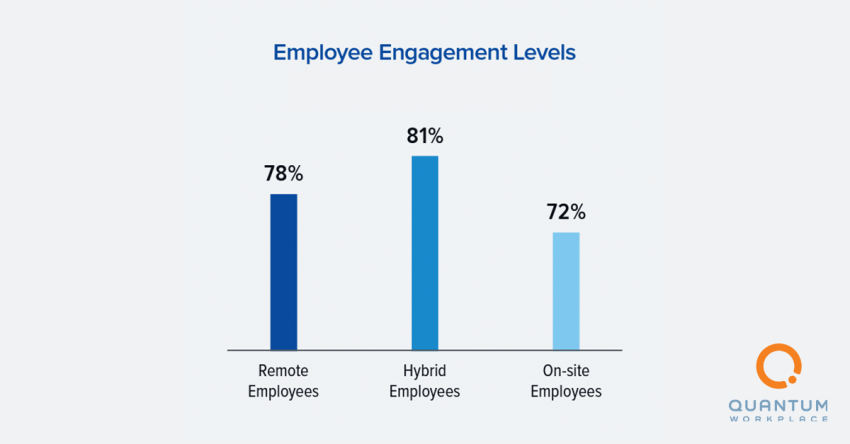
Key characteristics of hybrid work models
A hybrid work model is a workplace that combines in-office and remote employees or allows employees to alternate between working remotely and in-office.
This kind of work environment can take several forms, including:
- A combination of dedicated in-office and remote workers
- A set hybrid work schedule of in-office and remote workdays
- The flexibility for employees to choose when they work and where they work from
Many hybrid work models also have more flexible work arrangements, allowing employees to set their own hours as long as they still work a full eight hours per day.
This is particularly useful for companies with distributed workforces, as it empowers employees to work within their time zones or adjust their working hours when collaborating with coworkers or clients in different territories.
The most important aspect of a hybrid work model is the flexibility and autonomy it provides employees. Workers who can choose where and when to work (depending on their tasks and productivity) have more control over their work-life balance and can work during the hours when they’re most productive.
Benefits of hybrid work
What makes hybrid work so appealing for employees and employers? Hybrid work has several benefits, both for individual employees and organizations.
Benefits for employees
One of the biggest employee benefits is the improvement of work-life balance. Allowing employees to work remotely lets them avoid the daily commute, freeing up time and even reducing their carbon footprint (not to mention reducing the frustration of being stuck in rush hour traffic). A more flexible work schedule gives employees more time to spend with their families and attend appointments without cutting into their work.
A better work-life balance was voted the top benefit of remote work by 59% of respondents in a USA Today Blueprint study.
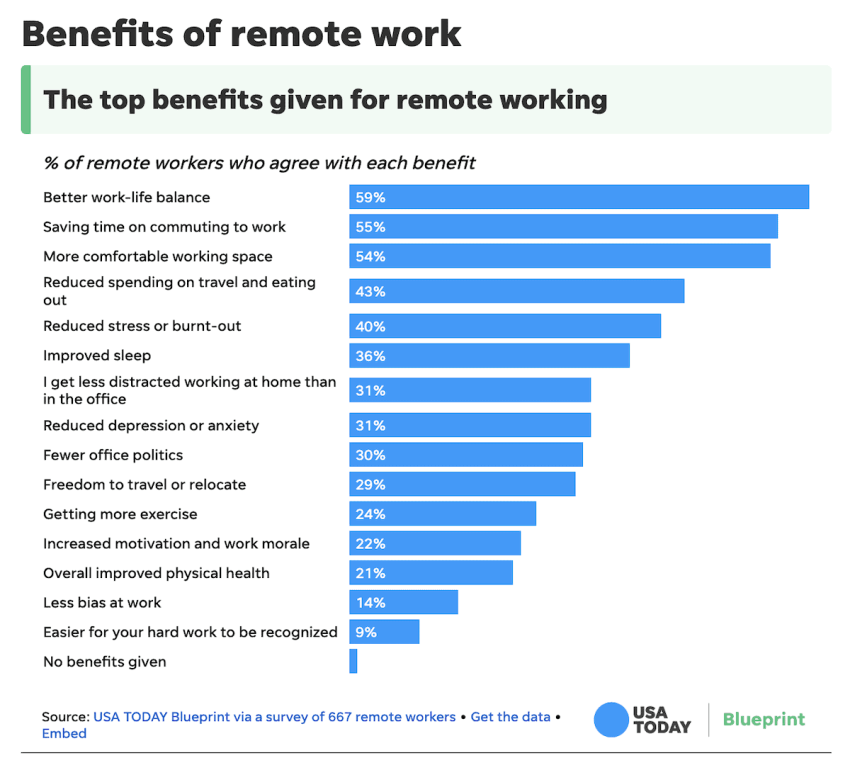
These improvements, in turn, increase employee engagement and satisfaction. Morale in hybrid work environments tends to be higher on average than in strictly in-office environments, as employees typically report high levels of satisfaction with the flexibility of hybrid work.
Many studies also suggest that employees work better when they have the flexibility to work remotely. A study from Gartner shows that nearly two-thirds of employees say they work best remotely and even feel more included when working in a remote environment.
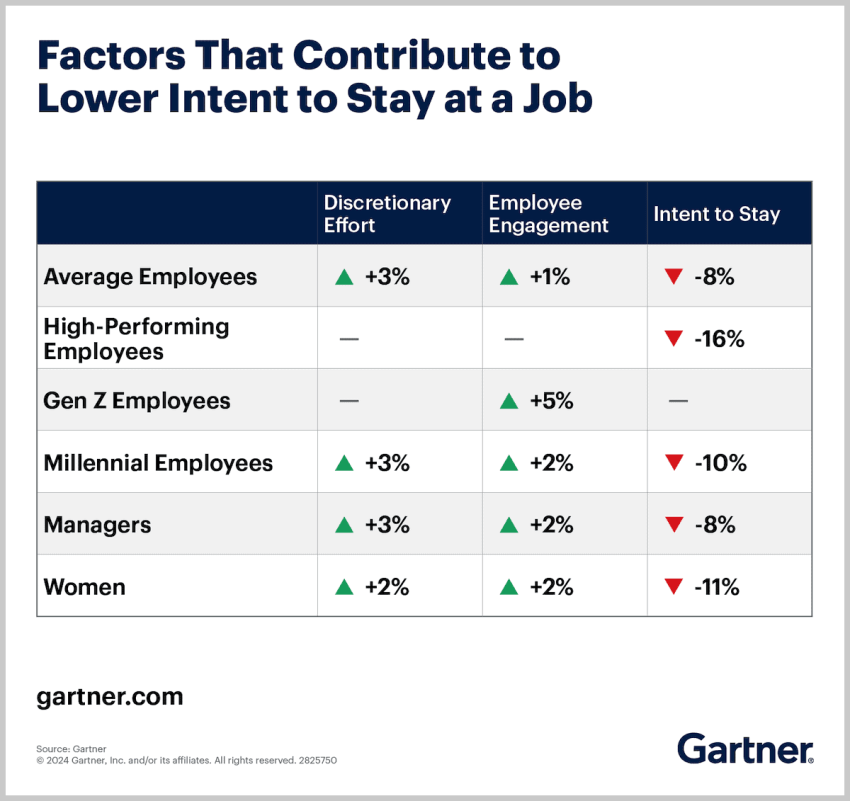
Gartner’s research shows that, on average, employees are more likely to leave an organization that mandates a return to the office than those that don’t. The data clearly shows that employees appreciate being able to work from anywhere.
Benefits for businesses
Businesses also see several benefits from a hybrid work environment. Naturally, high employee morale and reduced burnout benefit the organization as a whole, but that’s just the start. Hybrid work can lead to cost savings for companies, reducing the need for large office spaces as well as lowering power consumption.
Additionally, opening the doors to remote employees gives businesses access to a wider talent pool. When a company can hire employees from around the country or even the world without worrying about relocation, commute time, and other location-based issues, it suddenly has access to top-tier talent that would otherwise be out of reach.
Hybrid workplace challenges
For all the benefits of flexible work, creating and maintaining a healthy hybrid environment is not without some remote work challenges. For instance, maintaining a consistent company culture is more difficult with a distributed workforce. A company’s leadership and daily interactions help build its culture, and without people meeting and collaborating in person, it’s harder to build and manage.
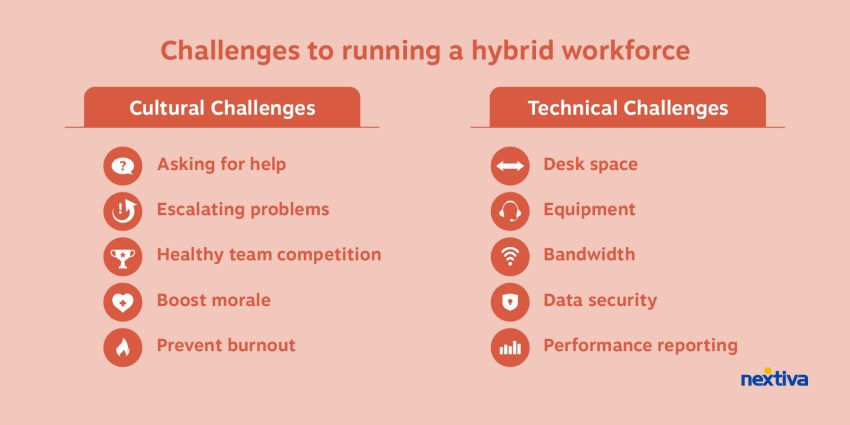
Another challenge is workload distribution. While companies can use project management tools to distribute and manage work remotely, it can still be easy to unintentionally give employees uneven workloads.
RTO vs. Hybrid Work Model
Let’s now examine the benefits and setbacks of hybrid work models and compare them with a mandated RTO model. This can help you decide whether your team works better when together in an office or if the flexibility of a hybrid work arrangement will be more beneficial.
| Feature | Return to Office | Hybrid Work Model |
|---|---|---|
| Flexibility | Low | High |
| Employee Morale | Can vary | Generally higher |
| Productivity | Can be high, depending on the environment | Can be high with proper setup |
| Collaboration | Often easier | Requires intentional effort |
| Cost | Higher operational costs | Potential cost savings on office space |
| Talent Acquisition | Can be limited | Access to a wider talent pool |
The benefits of hybrid work outweigh its challenges, although what works best for some organizations is not the best option for all. You’ll need to determine what’s best for your team.
What to Consider When Implementing a Hybrid Work Model
Having weighed up the pros and cons, you might feel it’s time to implement a hybrid work model for your organization. If you’re ready to invest in a hybrid environment, be sure to keep these factors in mind:
Role-based flexibility
With a hybrid work environment, some employees may want to work remotely or in-office full-time.
Here’s what a Stanford study showed on how often employees would like to have paid work days at home, depicting a strong interest in a hybrid work model.
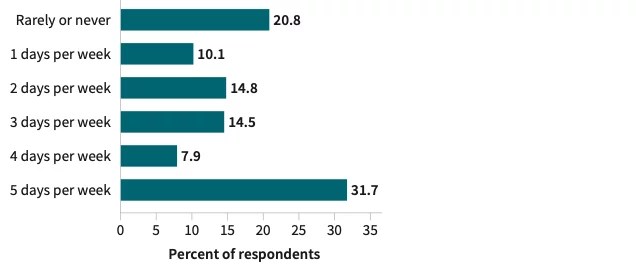
Consider which roles are best suited for remote, in-office, or hybrid work.
Many roles and departments, such as marketing, sales, and customer support, can be easily handled remotely. If employees have a good communications platform that lets them communicate and collaborate with coworkers, they can work from anywhere with an internet connection.
Other roles, however, simply can’t be done remotely. These include warehouse workers, medical technicians, and positions that may consist of building and testing hardware, interacting in person with clients or stakeholders, and providing IT services.
Technology infrastructure
Creating a hybrid work environment is not as easy as simply telling everyone they can work from home. You need to invest in the proper tools to keep your teams connected.
Be sure to invest in tools for remote collaboration and communication, such as a powerful unified communications (UC) solution that offers features like video meetings, file sharing, and messaging. You’ll also want good project management solutions to keep employees on track and ensure all projects are meeting their deadlines.

Company culture
An excellent hybrid work environment requires a strong company culture to thrive in. This means employees need to trust each other to accomplish the tasks they’re given (and be trusted in return). They should also have the autonomy to work where they’re comfortable without being micromanaged and be able to openly communicate.
Building a positive culture will empower employees to do their best work no matter where they are, knowing that they can always connect and collaborate.
Related: 13 Tips for Building an Amazing Remote Work Culture
Employee well-being
One of the most essential benefits of hybrid work is its positive impact on morale and work-life balance, but employers also need to ensure that they’re not sabotaging their own efforts.
Be sure to prioritize mental health. Allow employees to manage their time and schedules so they can keep up with their work and home obligations. Ensure they have access to resources they might need for their mental well-being. A happy and healthy employee is a loyal and productive employee.
Office space optimization
When half your team works remotely, you might find yourself with extra office space. So what do you do with all that real estate?
Consider redesigning your office spaces to support in-person collaboration and focus. This can take several different forms, such as adding huddle rooms, creating more open spaces, or turning empty offices into video meeting rooms, depending on your team’s needs.
Let’s look at the efficacy of video calls vs in-person meetings:
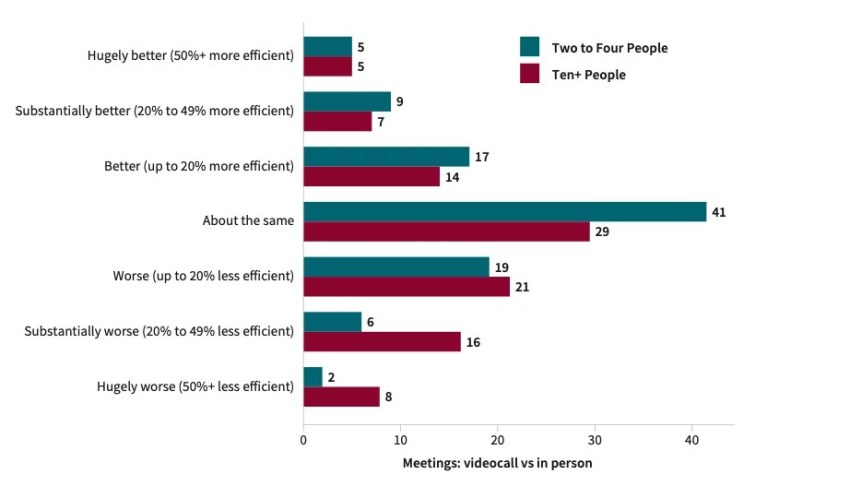
Clear policies and expectations
A hybrid work environment requires clear, agreed-upon guidelines for employees and employers alike. When implementing hybrid work, be sure to set clear guidelines for working remotely (such as how often employees are expected to be in the office), taking time off, and communicating during the workweek.
With these guidelines in place, your teams will be equipped to work efficiently whether they’re in the office or at home.
How a UC Platform Can Empower Hybrid Work
If you want to create a strong hybrid work environment, you need a UC platform that can support your workforce whether they’re working in-office, from home, or on the go.
Enhanced communication
UC platforms offer various communication channels, including voice, video, chat, and messaging, all from one location. This helps ensure seamless communication across your organization for both remote and in-office employees.
Improved collaboration
Many UC solutions offer collaboration tools like screen sharing, file sharing, and virtual whiteboards. These tools enable teamwork across long distances and empower employees to collaborate easily when working remotely.
Increased productivity
UC platforms place all employees’ communication tools on a single platform, typically with a unified interface. This streamlines communications, making it easier for employees to contact whoever they need through the best channel without constantly switching between tabs and applications.
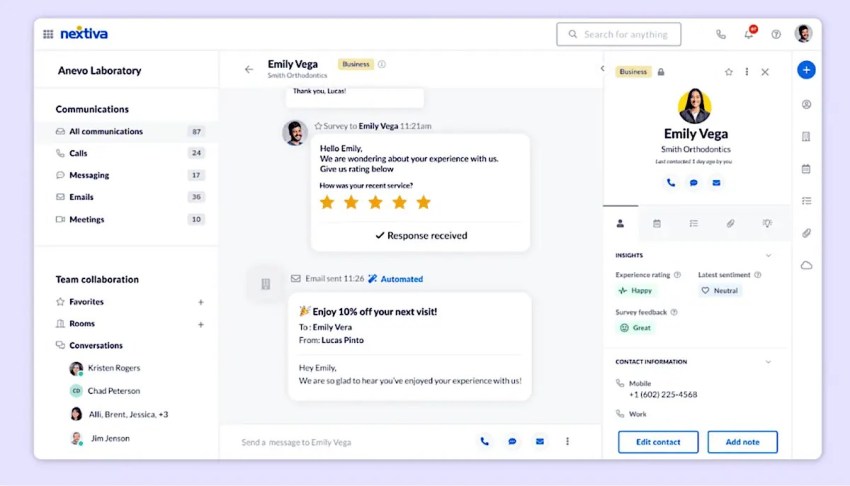
Cost savings
A UC platform offers communications across multiple platforms at a single price point. Compare that with using disparate communications tools, where you’ll need to pay for each one separately for every employee. Those costs will be significantly higher than those of a UC platform, and the expenses will only grow.
A UC solution reduces costs by consolidating multiple communications tools into a single platform.
Nextiva’s Hybrid Work Solution
Looking at the pros and cons of hybrid work and mandatory RTO models, it’s clear that employees prefer and can thrive in a hybrid work environment. Implementing a hybrid work strategy empowers employees to work and collaborate from anywhere while improving job satisfaction, teamwork, and work-life balance.
However, to support a hybrid workforce, you need the right tools and technology. This includes a powerful UC platform, such as Nextiva.
Nextiva’s omnichannel communications empower hybrid teams to work and communicate efficiently from anywhere — in the office, at home, or on a working vacation.
Nextiva offers a wide array of tools and features for employee communication, including:
- Cloud-based VoIP phone service, including call routing, auto attendants, and advanced call analytics
- Video conferencing for up to 100 participants, including screen sharing and screen recording
- Group and private messaging chats, including threads and file-sharing
- Integrations with popular business apps like Zendesk, Salesforce, and Office 365
If you’re ready to embrace hybrid work, Nextiva has everything you need to empower hybrid teams to do their best work anytime and anywhere.
Collab with your team anywhere.
Unify your teams, streamline interactions, and foster engagement with integrated team conversations – no matter where they are.

















 Leadership
Leadership 








